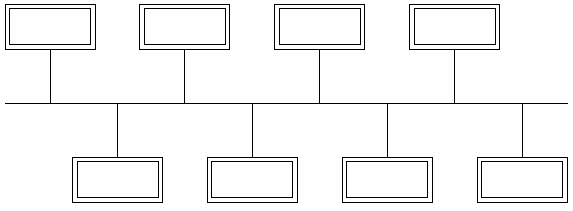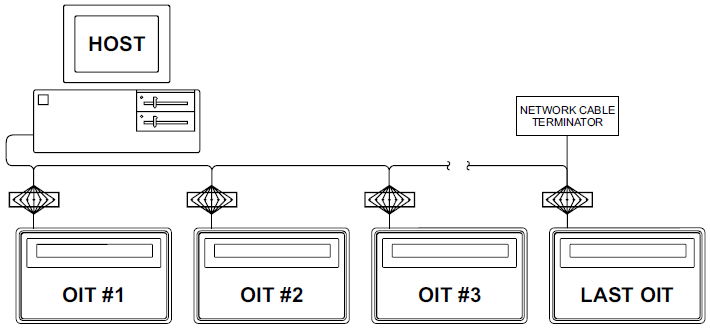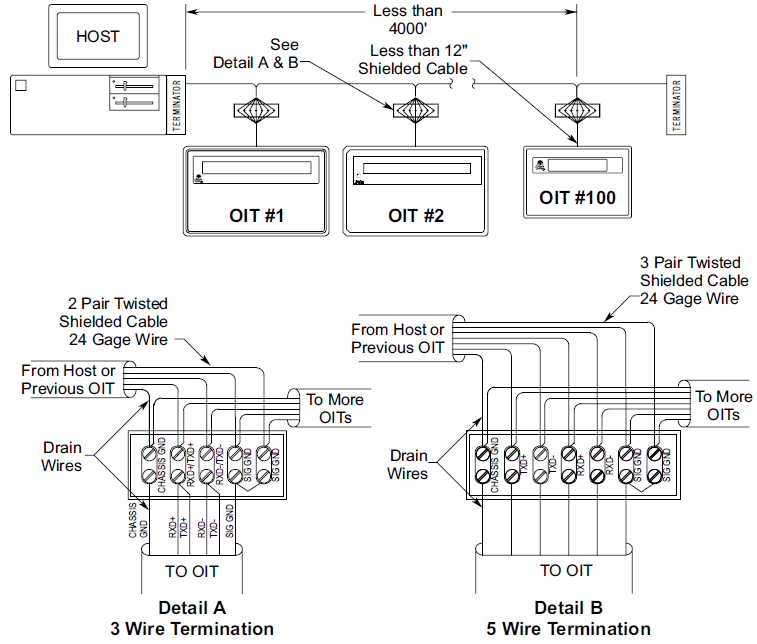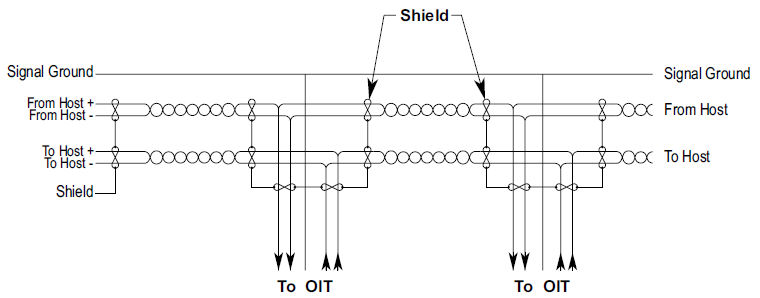Your cart is currently empty!
Applicable Model(s)
OIT Models
MAP Models
Title
Networking OITs using ASCII Protocol
Date
10/23/2005
Rev
01
P/N
0907-1054
Summary
Control systems often require operator input from a number of different locations in the system. A local network is desirable when multiple terminals are needed. The MAP and OIT operator interface terminal families can be configured so that they can be connected to a multidrop RS-485 network.
Network Formats
There are several different forms of communications networks. The format Maple Systems’
products utilize is multidrop (see Figure 1). The Multidrop network format is the one that will
be further discussed.

Multidrop Network
The MAP and OIT Product Families utilizing the STEP 1 protocol allows multiple Operator Interface Terminals (OITs), to be connected to a host controller. The host or master controller (located at one of the network ends) connected to multiple OITs via a single, continuous com-link. Each OIT is connected to the network by locally tapping into the com-link with short stub cables. Since the network is controlled by a single host controller, each end of the data link must be properly terminated to reduce noise pickup and interference. The total length of the data link, from the host to the end terminator, can be up to 4,000 feet long. The number of OITs that can be connected to the network is 100 or less, dependent upon the transceiver loading, data rate, and cable capacitance. Network repeaters can be added to the data link if needed, allowing additional OITs to be connected for each repeater used (up to a maximum of 255 units).
The host has the ability to communicate to any OIT on the network or all OITs at once. Each OIT on the network is a slave that transmits data only when requested by the host controller.
Some models of the Maple OITs have a jumper that must be moved to Position B when using RS-485 communications in a network. Refer to the “Set Jumper for Specific Protocol” section in the Installation Manual.
Communications Wiring
The OITs on the network must be connected to the host controller using a either 3-wire or 5-wire RS-485 com-link. The 5-wire com-link consists of 2 sets of twisted pairs and a signal ground. One of the twisted pair is connected from the host’s transmit lines to all of the OITs’ receive lines. The other twisted pair has all of the OITs’ transmit lines connected together and going into the host’s receive lines. Maple Systems recommends using a shielded cable with twisted wire. The transmit signals (TXD+ and TXD-) should be on one pair, the receive signals (RXD+ and RXD-) on another pair.
Improper pair matching may cause cross-talk between the transmit and receive lines resulting in loss of communications. The cable should be made of low-capacitance grade wire with at least 24 gauge. It should also have a shield drain wire and an overall foil shield for protection from external noise. The shield wire should be connected to earth ground.
For short networks (under 1,000 feet), low-capacitance 28-gage wire such as BELDEN #9805 or BELDEN #8133 can be used. For longer networks (over 1,000 feet) 24-gage wire such as BELDEN #9843 or BELDEN #8333 should be used. Each of these Belden cables consists of 3 sets of twisted pairs, so the signal ground is connected to one of the twisted pairs instead of a single wire.

Network Termination
The network data link must be properly terminated to reduce the amount of interference and noise pickup from the surrounding environment. This is accomplished by using a termination circuit at both ends of the network cable. Figure 3 shows a typical termination circuit. The host termination shown is only needed if the host’s RS-485 adapter does not contain any built-in terminator circuitry. The end termination must be done at the extreme end of the network cable.

Line reflections can occur in network connections that use long cables. This can cause data to be distorted or lost. In this case, terminating resistors are used to minimize the signal distortion. The terminating resistor must match the characteristic line impedance of the cable which is generally around 120 ohms. Only one resistor is required on the receive lines (RXD+ and RXD-) of the OIT that is farthest away from the host controller. The host’s receive lines must also be terminated with a 120 ohm resistor to minimize reflections coming back to the OITs.
Most RS485 cards have a pull-up and pull-down resistor, connected to the RS485 receiver lines to ensure that the data line remains in a known state when no communications is taking place between the host and the OITs. These resistors reduce the effect of transient noise on the data lines. If your host controller’s RS485 does not have these resistors in place, we recommend that they be installed as shown in Figure 3.
Terminal Connection
Multiple stations of OITs should be connected to the host controller using a ‘daisy chain’ configuration. This means that each OIT must be connected in-line with one cable running from the host controller to each OIT on the network.
As shown in Figure 4, each OIT “taps off” the main line with a short stub cable. This stub cable should be as short as possible to reduce line reflections. We recommend a distance of less than 12” for each stub cable. A terminal block is used at the point at which the stub cable separates from the main cable to facilitate connections between OITs. Note that the shield wire is also connected to the terminal block in order to maintain connection between cables for maximum protection against noise. For proper shielding, all of the cable shields should be connected together with the shield wire connected to an earth/chassis ground point at the host. Each stub cable should have it’s shield wire connected to the OIT’s chassis ground pin.

Network Grounding
To communicate properly, serious attention must be paid to the grounding scheme of any device connected to the network com-link. Improper grounding, termination, and faulty shielding of the com-link is one of the most common causes of system failure in a multidrop network. For proper operation, the following general rules must be observed:
1.
The cable shield must not be used as the signal ground.

It is tempting to try and reduce the cost of the cabling by using a 4 wire cable with the shield
used as the signal ground, DON’T DO IT. The initial cost savings are always exceeded by the
maintenance costs once the system is operating under field conditions. Often, it is necessary to
completely replace the network data link with the proper cable (5 wire plus shield) to eliminate
noise problems in the system.
2.
The signal ground must not be connected to the chassis or earth ground.
The chassis ground is intended as a safety ground for power supplies, EMI filters, voltage spike protection circuits, 120 VAC neutral returns, and all manner of AC and DC driven devices. As a result, the chassis ground can carry large voltage potentials and currents. Connecting the signal ground to the chassis ground can damage the device connected to the network data link.
3.
Other Considerations
The most common error when installing the network is running power lines (especially 110 VAC) in the same wire channel as the network data link. This is often done to reduce the cost of the wire conduit. Including a 110 VAC, 60 hz line in the wire channel is sure to cause loss of communications on a regular basis. If the AC line is powering relays, motors, or even fluorescent lighting, the high voltage spikes and noise WILL BE induced on the network data link, destroying any or all attached network devices. 208 VAC three phase power is even worse, since the voltage spikes and noise is of greater magnitude and intensity.
Short runs of low voltage DC power can normally be included in a communications wiring channel or cable. This allows the use a single stub cable to connect to the com-link and its local power supply. However, DC power should not be run down the whole length of the network to power every device. Small clusters of OITs (two or three terminals) that are physically adjacent may be powered from a single supply if necessary.
